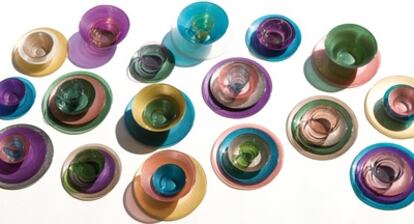"Nano"-effects in your coffee maker?
This development is the fruit of enormous advances in polymer science. Many materials were made resistant to ultraviolet (UV) radiation or environmental chemicals. Introduction of carbon or glass fibres made the polymers mechanically stronger.
Despite these undoubtedly major advances in the last 20-30 years, the deformation of plastics at the microscopic level in one class of plastics, the semicrystalline polymers, is yet to be fully understood. Semicrystalline polymers consist of a crystalline part and an amorphous or glassy part. The most important plastics in terms of application, such as polyethylene (PE), polypropylene (PP), and nylon (PA), fall into this category. Since the crystalline phase is usually much harder than the amorphous one, it greatly influences the strength of the material. Interestingly, however, it is not so much the relative volumes of the two different phases as the thickness of the crystalline area that is crucial. During crystallization from the melt, the so-called lamellae, extremely thin platelets with only a few nanometres (a few billionth of a metre) thickness, are formed. A plausible explanation for this behaviour may lie in the existence of small irregularities in the structure of the crystalline lattice of the lamellae and in their ability to move. Among such lattice defects, linear defects, the dislocations, are the main carriers of plastic deformation in many crystalline materials and thus play a crucial role in their strength: in semicrystalline polymers, however, their role is controversial so far.
It was the research group on nanostructured materials of the physics faculty at the University of Vienna that, for the first time, proved the existence of dislocations in melt crystallised polypropylene, which is the state in which the material is usually shipped by the manufacturer. The group used X-ray diffraction, to measure the characteristic lattice distortion, a sort of fingerprint of a particular dislocation. Subsequently, the group could not only count the number of dislocations but also correlate that number with the mechanical properties. It appears that in metals with grain sizes, i.e. crystal sizes, in the nanometer range, as well as in semicrystalline polymers, the smaller the crystals, the weaker the material. There are some indications that similar deformation mechanisms are active despite large differences in the structure and the bonding. In the case of both, metals and polymers, the scientific community is divided about the precise role of dislocations in the properties of these smallest crystallites, and fundamental understanding of the nanostructure of metals and of polymers will prove mutually supportive.
Even basic research needs to consider possible applications although they may not be obvious at first sight. In the present case, however, this question can be easily answered: if it is possible to manipulate the number, arrangement and mobility of dislocations in semicrystalline polymers - and some promising approaches have been reported in international literature - both metals and polymers can be made far stronger and ductile (that is, they could be drawn into extremely fine strands), thereby opening completely new fields of application of plastics just as resistance to UV did several decades ago.

Tu suscripción se está usando en otro dispositivo
¿Quieres añadir otro usuario a tu suscripción?
Si continúas leyendo en este dispositivo, no se podrá leer en el otro.
FlechaTu suscripción se está usando en otro dispositivo y solo puedes acceder a EL PAÍS desde un dispositivo a la vez.
Si quieres compartir tu cuenta, cambia tu suscripción a la modalidad Premium, así podrás añadir otro usuario. Cada uno accederá con su propia cuenta de email, lo que os permitirá personalizar vuestra experiencia en EL PAÍS.
¿Tienes una suscripción de empresa? Accede aquí para contratar más cuentas.
En el caso de no saber quién está usando tu cuenta, te recomendamos cambiar tu contraseña aquí.
Si decides continuar compartiendo tu cuenta, este mensaje se mostrará en tu dispositivo y en el de la otra persona que está usando tu cuenta de forma indefinida, afectando a tu experiencia de lectura. Puedes consultar aquí los términos y condiciones de la suscripción digital.
Archivado En
Últimas noticias
La Fiscalía de Ciudad de México confirma que el hombre asesinado en la Zona Rosa era El Panu, jefe de seguridad de Los Chapitos
Navitrans, una cena de navidad para personas LGBT+ en condición de calle y trabajadoras sexuales
Bolsonaro deja la cárcel para operarse de una hernia
Bonoloto: comprobar sorteo del jueves 25 de diciembre
Lo más visto
- La revalorización de las pensiones queda en el aire por la negativa de la derecha a apoyar otras medidas sociales
- Zelenski confirma que cualquier pacto con Rusia deberá ser ratificado en referéndum
- Los ‘whatsapps’ de Mazón a Feijóo del día de la dana: “Un puto desastre va a ser esto presi”
- Víctor Bermúdez, profesor de Filosofía: “Hemos perdido el control del proceso educativo, lo que damos en clase es en gran medida un simulacro”
- El líder groenlandés responde a Trump: “Groenlandia es nuestro país. Nuestras decisiones se toman aquí”




























































